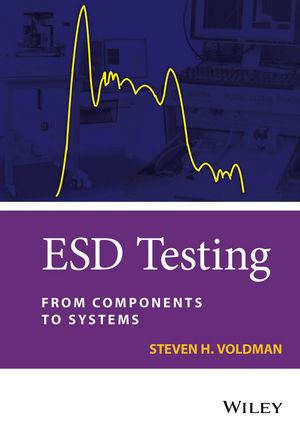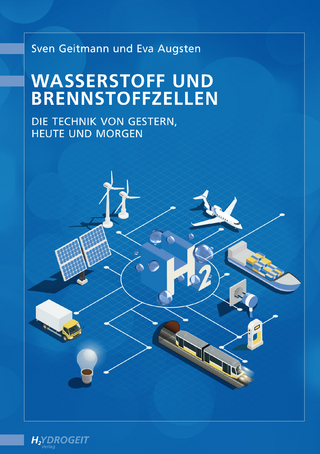
ESD Testing
John Wiley & Sons Inc (Verlag)
978-0-470-51191-6 (ISBN)
- Titel z.Zt. nicht lieferbar
- Versandkostenfrei innerhalb Deutschlands
- Auch auf Rechnung
- Verfügbarkeit in der Filiale vor Ort prüfen
- Artikel merken
With the evolution of semiconductor technology and global diversification of the semiconductor business, testing of semiconductor devices to systems for electrostatic discharge (ESD) and electrical overstress (EOS) has increased in importance.
ESD Testing: From Components to Systems updates the reader in the new tests, test models, and techniques in the characterization of semiconductor components for ESD, EOS, and latchup.
Key features:
Provides understanding and knowledge of ESD models and specifications including human body model (HBM), machine model (MM), charged device model (CDM), charged board model (CBM), cable discharge events (CDE), human metal model (HMM), IEC 61000-4-2 and IEC 61000-4-5.
Discusses new testing methodologies such as transmission line pulse (TLP), to very fast transmission line pulse (VF-TLP), and future methods of long pulse TLP, to ultra-fast TLP (UF-TLP).
Describes both conventional testing and new testing techniques for both chip and system level evaluation.
Addresses EOS testing, electromagnetic compatibility (EMC) scanning, to current reconstruction methods.
Discusses latchup characterization and testing methodologies for evaluation of semiconductor technology to product testing.
ESD Testing: From Components to Systems is part of the authors’ series of books on electrostatic discharge (ESD) protection; this book will be an invaluable reference for the professional semiconductor chip and system-level ESD and EOS test engineer. Semiconductor device and process development, circuit designers, quality, reliability and failure analysis engineers will also find it an essential reference. In addition, its academic treatment will appeal to both senior and graduate students with interests in semiconductor process, device physics, semiconductor testing and experimental work.
Dr Steven H. Voldman, IEEE Fellow, Vermont, USA Dr. Steven H. Voldman is the first IEEE Fellow in the field of electrostatic discharge (ESD) for "Contributions in ESD protection in CMOS, Silicon On Insulator and Silicon Germanium Technology." Voldman was a member of the semiconductor development of IBM for 25 years as well as a consultant for TSMC, and Samsung Electronics. Dr. Voldman initiated the first transmission line pulse (TLP) standard development team, and a participant in the JEDEC-ESD Association standards harmonization of the human body model (HBM) Standard. From 2000 to 2013, as Chairman of the ESD Association Work Group on TLP and very-fast TLP (VF-TLP), his team was responsible for initiating the first standard practice and standards for TLP and VF-TLP. He initiated the "ESD on Campus" program which was established to bring ESD lectures and interaction to university faculty and students internationally; the ESD on Campus program has reached over 40 universities in the United States, Korea, Singapore, Taiwan, Malaysia, Philippines, Thailand, India, and China. Dr. Voldman teaches short courses and tutorials on ESD, latchup, patenting, and invention.
About the Author xvii
Preface xix
Acknowledgments xxiii
1 Introduction 1
1.1 Testing for ESD, EMI, EOS, EMC, and Latchup 1
1.2 Component and System Level Testing 1
1.3 Qualification Testing 2
1.4 ESD Standards 3
1.5 Component Level Standards 6
1.6 System Level Standards 7
1.7 Factory and Material Standards 7
1.8 Characterization Testing 8
1.9 ESD Library Characterization and Qualification 12
1.10 ESD Component Standards and Chip Architectures 12
1.11 System Level Characterization 13
1.12 Summary and Closing Comments 13
Problems 14
References 15
2 Human Body Model 17
2.1 History 17
2.2 Scope 18
2.3 Purpose 18
2.4 Pulse Waveform 18
2.5 Equivalent Circuit 19
2.6 Test Equipment 20
2.7 Test Sequence and Procedure 23
2.8 Failure Mechanisms 25
2.9 HBM ESD Current Paths 26
2.10 HBM ESD Protection Circuit Solutions 28
2.11 Alternate Test Methods 32
2.12 HBM Two-Pin Stress 34
2.13 HBM Small Step Stress 37
2.14 Summary and Closing Comments 38
Problems 39
References 39
3 Machine Model 43
3.1 History 43
3.2 Scope 43
3.3 Purpose 43
3.4 Pulse Waveform 44
3.5 Equivalent Circuit 45
3.6 Test Equipment 45
3.7 Test Sequence and Procedure 47
3.8 Failure Mechanisms 49
3.9 MM ESD Current Paths 49
3.10 MM ESD Protection Circuit Solutions 52
3.11 Alternate Test Methods 55
3.12 Machine Model to Human Body Model Ratio 57
3.13 Machine Model Status as an ESD Standard 58
3.14 Summary and Closing Comments 58
Problems 59
References 59
4 Charged Device Model (CDM) 61
4.1 History 61
4.2 Scope 61
4.3 Purpose 62
4.4 Pulse Waveform 62
4.5 Equivalent Circuit 65
4.6 Test Equipment 65
4.7 Test Sequence and Procedure 67
4.8 Failure Mechanisms 69
4.9 CDM ESD Current Paths 70
4.10 CDM ESD Protection Circuit Solutions 72
4.11 Alternative Test Methods 74
4.12 Charged Board Model (CBM) 75
4.13 Summary and Closing Comments 77
Problems 79
References 80
5 Transmission Line Pulse (TLP) Testing 84
5.1 History 84
5.2 Scope 85
5.3 Purpose 85
5.4 Pulse Waveform 86
5.5 Equivalent Circuit 87
5.6 Test Equipment 88
5.7 Test Sequence and Procedure 95
5.8 TLP Pulsed I–V Characteristic 98
5.9 Alternate Methods 101
5.10 TLP-to-HBM Ratio 104
5.11 Summary and Closing Comments 104
Problems 104
References 105
6 Very Fast Transmission Line Pulse (VF-TLP) Testing 108
6.1 History 108
6.2 Scope 108
6.3 Purpose 108
6.4 Pulse Waveform 109
6.5 Equivalent Circuit 111
6.6 Test Equipment Configuration 111
6.7 Test Sequence and Procedure 117
6.8 VF-TLP Pulsed I–V Characteristics 121
6.9 Alternate Test Methods 124
6.10 Summary and Closing Comments 125
Problems 128
References 128
7 IEC 61000-4-2 130
7.1 History 130
7.2 Scope 130
7.3 Purpose 130
7.4 Pulse Waveform 131
7.5 Equivalent Circuit 133
7.6 Test Equipment 133
7.7 Test Sequence and Procedure 135
7.8 Failure Mechanisms 137
7.9 IEC 61000-4-2 ESD Current Paths 138
7.10 ESD Protection Circuitry Solutions 139
7.11 Alternative Test Methods 140
7.12 Summary and Closing Comments 143
Problems 143
References 144
8 Human Metal Model (HMM) 147
8.1 History 147
8.2 Scope 147
8.3 Purpose 148
8.4 Pulse Waveform 148
8.5 Equivalent Circuit 149
8.6 Test Equipment 149
8.7 Test Configuration 150
8.8 Test Sequence and Procedure 153
8.9 Failure Mechanisms 157
8.10 ESD Current Paths 158
8.11 ESD Protection Circuit Solutions 158
8.12 Summary and Closing Comments 160
Problems 160
References 161
9 IEC 61000-4-5 163
9.1 History 163
9.2 Scope 164
9.3 Purpose 164
9.4 Pulse Waveform 165
9.5 Equivalent Circuit 166
9.6 Test Equipment 166
9.7 Test Sequence and Procedure 168
9.8 Failure Mechanisms 168
9.9 IEC 61000-4-5 ESD Current Paths 170
9.10 ESD Protection Circuit Solutions 170
9.11 Alternate Test Methods 171
9.12 Summary and Closing Comments 171
Problems 172
References 172
10 Cable Discharge Event (CDE) 174
10.1 History 174
10.2 Scope 175
10.3 Purpose 175
10.4 Cable Discharge Event – Charging, Discharging, and Pulse Waveform 175
10.5 Equivalent Circuit 178
10.6 Test Equipment 179
10.7 Test Measurement 180
10.8 Test Procedure 185
10.9 Measurement of a Cable in Different Conditions 185
10.10 Transient Field Measurements 195
10.11 Telecommunication Cable Discharge Test System 195
10.12 Cable Discharge Current Paths 200
10.13 Failure Mechanisms 200
10.14 Cable Discharge Event (CDE) Protection 201
10.15 Alternative Test Methods 203
10.16 Summary and Closing Comments 204
Problems 204
References 204
11 Latchup 206
11.1 History 206
11.2 Purpose 208
11.3 Scope 209
11.4 Pulse Waveform 209
11.5 Equivalent Circuit 209
11.6 Test Equipment 209
11.7 Test Sequence and Procedure 211
11.8 Failure Mechanisms 215
11.9 Latchup Current Paths 216
11.10 Latchup Protection Solutions 216
11.11 Alternate Test Methods 222
11.12 Single Event Latchup (SEL) Test Methods 224
11.13 Summary and Closing Comments 224
Problems 227
References 227
12 Electrical Overstress (EOS) 230
12.1 History 230
12.2 Scope 232
12.3 Purpose 233
12.4 Pulse Waveform 233
12.5 Equivalent Circuit 233
12.6 Test Equipment 234
12.7 Test Procedure and Sequence 234
12.8 Failure Mechanisms 236
12.9 Electrical Overstress (EOS) Protection Circuit Solutions 240
12.10 Electrical Overstress (EOS) Testing – TLP Method and EOS 249
12.11 Electrical Overstress (EOS) Testing – DC and Transient Latchup Testing 252
12.12 Summary and Closing Comments 252
Problems 252
References 253
13 Electromagnetic Compatibility (EMC) 257
13.1 History 257
13.2 Purpose 258
13.3 Scope 258
13.4 Pulse Waveform 258
13.5 Equivalent Circuit 259
13.6 Test Equipment 259
13.7 Test Procedures 261
13.8 Failure Mechanisms 261
13.9 ESD/EMC Current Paths 263
13.10 EMC Solutions 264
13.11 Alternative Test Methods 266
13.12 EMC/ESD Product Evaluation – IC Prequalification 267
13.13 EMC/ESD Scanning Detection – Upset Evaluation 267
13.14 EMC/ESD Product Qualification Process 268
13.15 Alternative ESD/EMC Scanning Methods 271
13.16 Current Reconstruction Methodology 276
13.17 Printed Circuit Board (PCB) Design EMC Solutions 277
13.18 Summary and Closing Comments 280
Problems 281
References 282
A Glossary of Terms 284
B Standards 288
B.1 ESD Association 288
B.2 International Organization of Standards 289
B.3 IEC 289
B.4 RTCA 289
B.5 Department of Defense 289
B.6 Military Standards 289
B.7 Airborne Standards and Lightning 290
Index 291
| Erscheint lt. Verlag | 19.12.2016 |
|---|---|
| Verlagsort | New York |
| Sprache | englisch |
| Maße | 175 x 246 mm |
| Gewicht | 635 g |
| Themenwelt | Technik ► Elektrotechnik / Energietechnik |
| ISBN-10 | 0-470-51191-5 / 0470511915 |
| ISBN-13 | 978-0-470-51191-6 / 9780470511916 |
| Zustand | Neuware |
| Haben Sie eine Frage zum Produkt? |
aus dem Bereich


